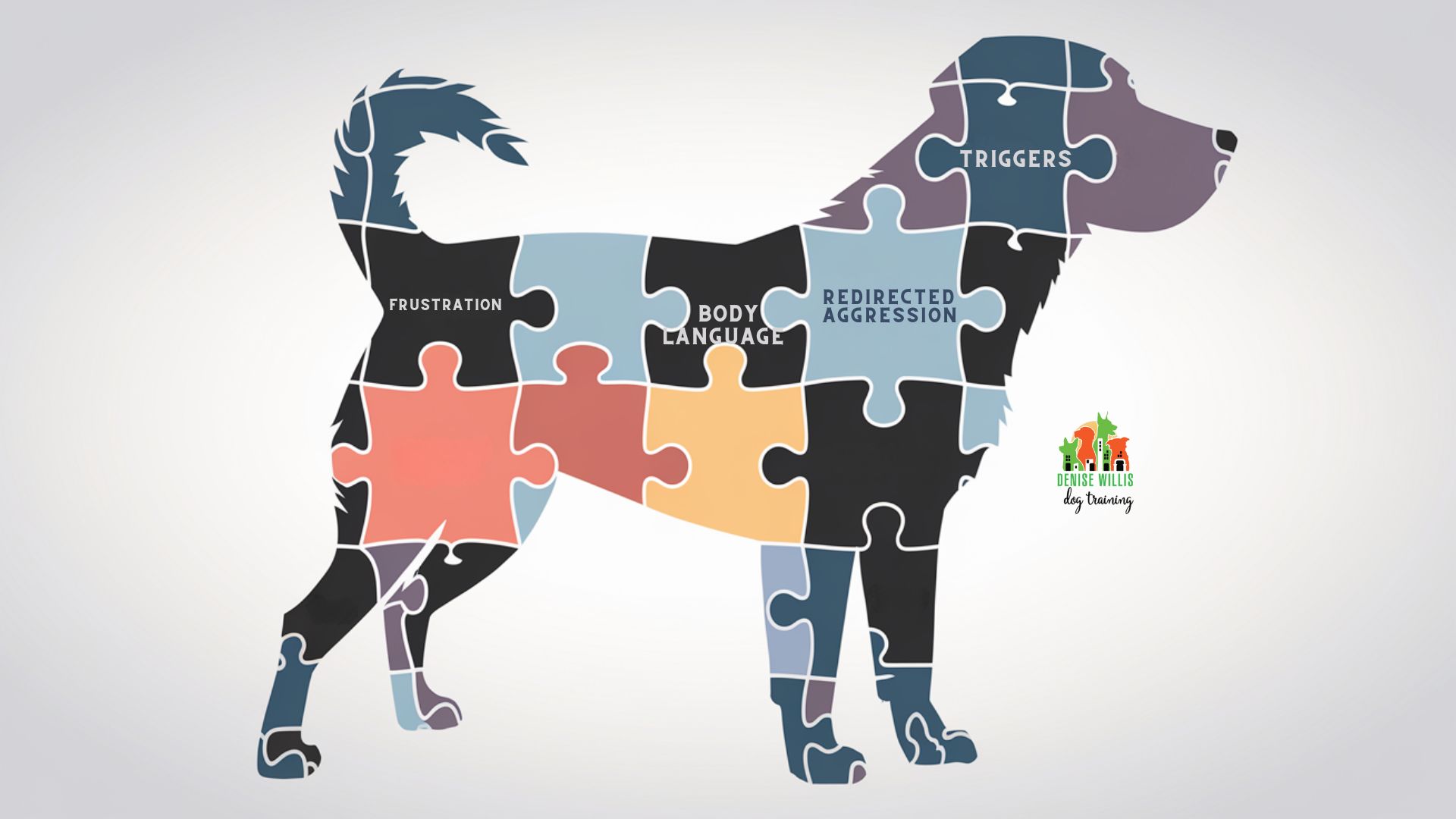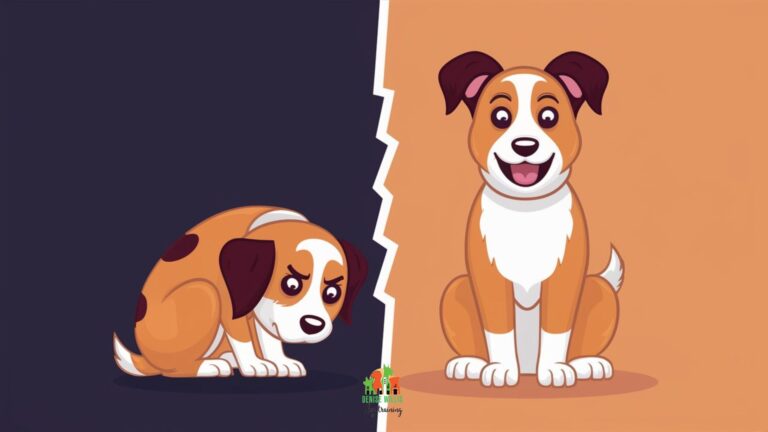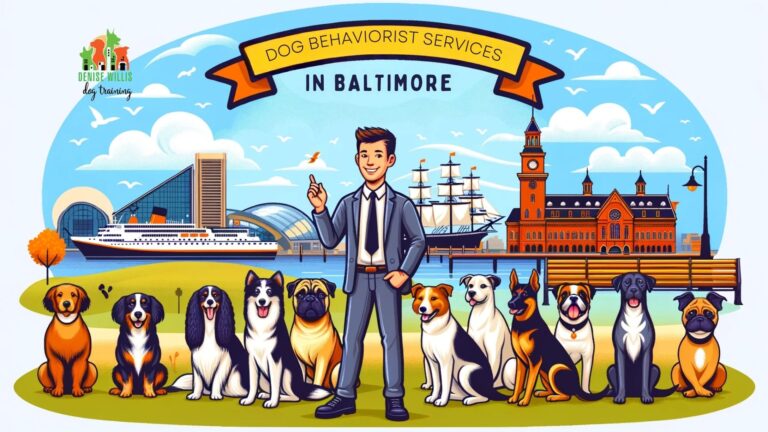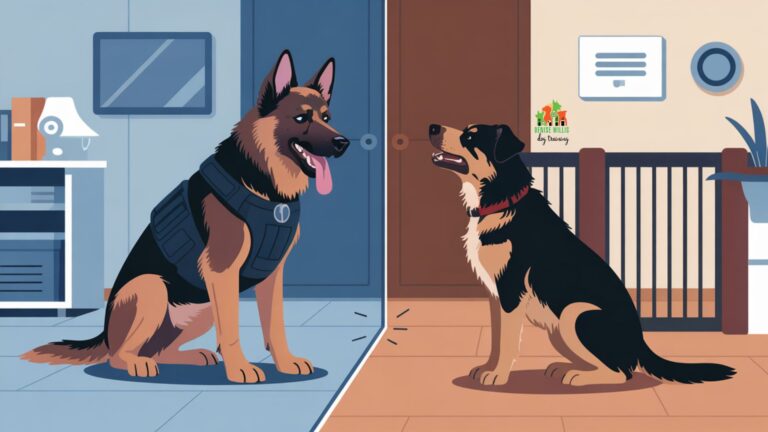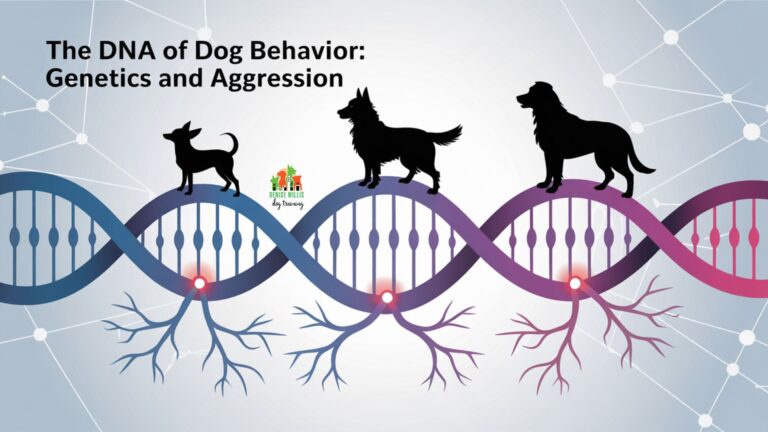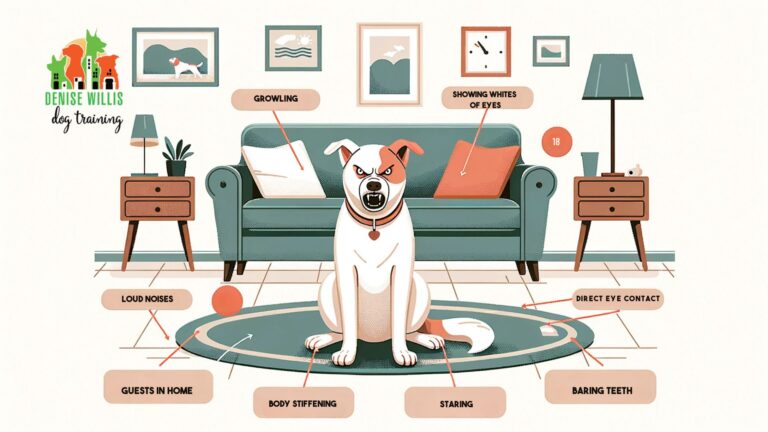When Good Dogs Attack: Understanding Redirected Aggression in Dogs
📍 Service Area Notice: DW Dog Training provides in-person training services exclusively in the Greater Baltimore area. While our blog content is designed to help dog owners internationally, our hands-on training services are locally focused. For readers outside our service area, we hope you find value in our articles and welcome you to reach out with questions!
Have you ever wondered why your normally well-behaved dog suddenly lashes out at you or another pet for seemingly no reason?
This perplexing behavior, known as redirected aggression in dogs, can leave pet owners feeling confused and concerned. It’s a common yet often misunderstood issue that can strain the bond between dogs and their human companions.
Redirected aggression occurs when a dog becomes aroused by a trigger they can’t directly respond to, causing them to redirect their frustration onto an unrelated target nearby. This behavior can manifest in various ways, from growling and snapping to full-blown bites, potentially leading to serious consequences if left unaddressed.
Understanding the underlying causes and recognizing the signs of redirected aggression can be crucial in maintaining a harmonious relationship with your furry friend. By looking into this topic, you’ll gain valuable insights that may help you better manage your dog’s behavior and create a safer, more peaceful environment for everyone in your household.
Key Takeaways
- Redirected aggression occurs when a dog can’t address the source of its frustration
- Common triggers include barrier frustration, interrupted conflicts, and overstimulation
- Prevention involves identifying triggers, environmental management, and training
- Professional help may be necessary for severe cases
- Understanding and patience are crucial in managing this behavior
The Science Behind the Snap
To understand redirected aggression, we need to don our lab coats and dive into the fascinating world of canine neuroscience. When your dog gets worked up, their brain essentially turns into a chaotic puppy party, complete with hormonal confetti and neurotransmitter noise-makers.
Stress hormones like cortisol and adrenaline flood your dog’s system faster than treats disappear from an unattended plate. These hormones prepare the body for a “fight or flight” response, increasing heart rate, blood pressure, and muscle tension. This physiological state can make your dog more reactive and less able to think clearly or respond to commands.
Neurotransmitters, the chemical messengers in the brain, go haywire, turning your dog’s mood into a neurochemical rollercoaster. Serotonin, often called the “feel-good” neurotransmitter, can become depleted, potentially leading to increased aggression. Meanwhile, dopamine levels may spike, intensifying your dog’s focus on the trigger and making it harder for them to disengage.
Your pup’s senses go into overdrive, making them more alert than a squirrel at a nut convention. This heightened state of arousal can cause your dog to overreact to stimuli they might normally ignore, like a passing car or a neighbor’s voice.
This perfect storm of biological chaos can lead to impulsive decisions that make about as much sense as a cat in a dog costume. It’s crucial to remember that when your dog is in this state, they’re not making rational decisions. They’re reacting based on pure instinct and emotion, which is why redirected aggression can seem so out of character for many dogs.
Timeline of Redirected Aggression Research and Understanding
1990
Increased research on canine aggression and behavior; initial classifications of redirected aggression.
2005
Significant studies highlighting the underlying causes of redirected aggression, linking it to frustration and arousal.
2010
Publication of multiple papers discussing the behavioral modifications associated with redirected aggression.
2015
Emergence of practical guidelines for managing redirected aggression in dogs.
2020
Increased awareness and understanding of redirected aggression in canine behavior among professionals and pet owners.
Types of Redirected Aggression
Redirected aggression in dogs can manifest in various ways, each presenting unique challenges for dog owners and trainers. Understanding these different types can help in identifying and addressing the issue more effectively.
Intra-species Redirection
This is when your dog decides to take out their frustrations on another canine companion. It’s like the doggy version of “Kick the cat,” except everyone involved has sharper teeth. Intra-species redirection often occurs in multi-dog households or at dog parks. For example, two dogs might be playing when a third dog approaches. If one of the playing dogs feels threatened but can’t reach the approaching dog, they might redirect their aggression onto their playmate.
This type of redirection can be particularly challenging as it can damage relationships between dogs that normally get along well. It’s essential to be aware of each dog’s body language and intervene before play escalates into aggression.
Inter-species Redirection
Here, your pup might decide that the nearest human or unsuspecting squirrel looks like a good target for their pent-up energy. It’s an equal opportunity aggression – no species discrimination here! This type of redirection can be especially dangerous when humans are involved, as it can lead to bite incidents.
For instance, a dog might become agitated by a passing motorcycle but, unable to chase it, turns and nips at their owner instead. This behavior can be particularly confusing and upsetting for owners who may not understand why their normally loving pet suddenly turned on them.
Object-directed Redirection
Sometimes, inanimate objects bear the brunt of your dog’s misplaced aggression. That innocent fire hydrant never saw it coming. While this might seem less serious than aggression directed at living beings, it can still be problematic. A dog might destroy household items, damage property, or even injure themselves in their frustrated state.
For example, a dog might become aroused by squirrels in the yard but, confined indoors, starts to chew destructively on furniture or scratch at doors. This behavior not only causes damage but can also be a sign of significant stress and frustration that needs to be addressed.
Understanding these different types of redirected aggression is crucial for developing effective management and treatment strategies. Each type may require a slightly different approach, but all benefit from patience, consistency, and positive reinforcement training techniques.
Common Scenarios
Redirected aggression doesn’t just happen out of the blue. There are several common scenarios where this behavior is more likely to occur. Recognizing these situations can help you predict and prevent potential incidents.
Barrier Frustration
Picture this: Your dog spots a squirrel through the fence. Unable to chase it, they turn their frustration on the nearest target – which could be you, another pet, or that innocent garden gnome. Barrier frustration is a common trigger for redirected aggression, and it’s not limited to fences. Windows, leashes, and even crates can create the same effect.
This scenario often plays out during walks when a dog on a leash sees another dog or an exciting stimulus they can’t reach. The inability to approach or flee can cause intense frustration, leading to redirected aggression towards the owner or anything else within reach.
To manage barrier frustration:
- Use positive reinforcement to teach your dog to focus on you when they see triggers
- Gradually desensitize your dog to the presence of exciting stimuli behind barriers
- Consider using tools like window film to reduce visual access to outdoor triggers
Interrupted Conflicts
You step in to break up a doggy disagreement, and suddenly you’re the new target. It’s like being the referee in a canine boxing match – sometimes you catch a right hook. This scenario is particularly dangerous for owners and highlights the importance of safe intervention techniques.
When dogs are in a highly aroused state during a conflict, their bite inhibition (the learned behavior of controlling the force of their bite) may be reduced. This means that even if your dog would never normally bite you, they might do so in this heightened state.
To safely handle interrupted conflicts:
- Use distraction techniques like loud noises or water sprays to break up fights from a distance
- Never physically place yourself between fighting dogs
- Train a solid “leave it” or recall command for emergencies
Overstimulation
Too much excitement can lead to poor decisions. It’s the doggy equivalent of that friend who always takes things too far at parties. Overstimulation can occur in both positive and negative situations – a dog might redirect aggression during an exciting game just as easily as during a stressful vet visit.
Signs of overstimulation include:
- Excessive barking or whining
- Jumping or spinning
- Mouthing or nipping
- Inability to respond to familiar commands
To prevent overstimulation:
- Provide regular breaks during play or exciting activities
- Teach your dog a “settle” or “calm” command
- Create a quiet, safe space where your dog can retreat when overwhelmed
By understanding these common scenarios, you can better predict when redirected aggression might occur and take steps to prevent it. Remember, the key is to manage your dog’s environment and emotional state to set them up for success.
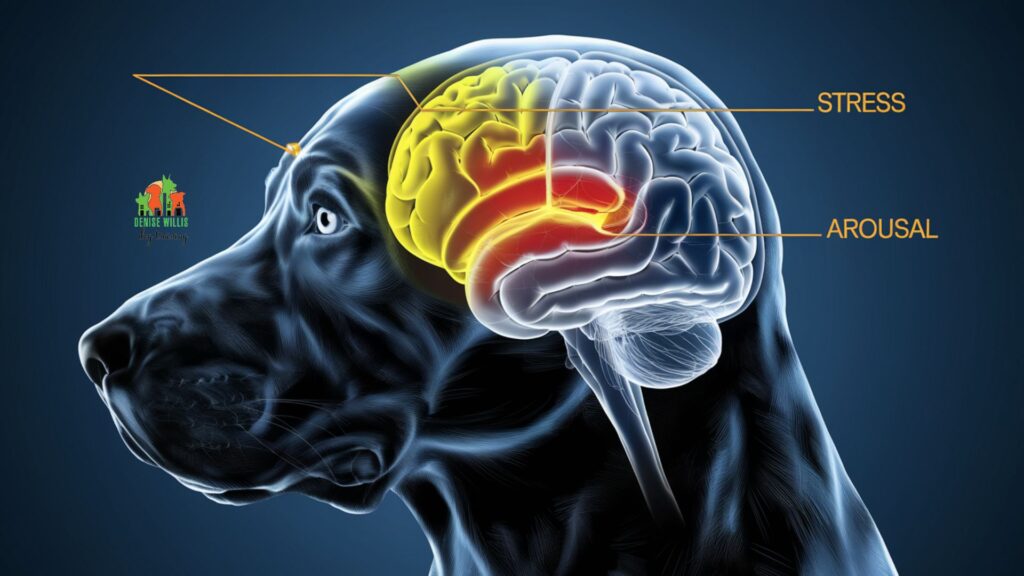
Risk Factors
When it comes to redirected aggression, some dogs are more susceptible than others. Understanding these risk factors can help you assess your dog’s likelihood of displaying this behavior and take appropriate preventative measures.
Breed Tendencies
Some breeds are more prone to reactivity. It’s not their fault – blame their great-great-grandpawrents. Certain breeds were developed for jobs that required quick reactions and high arousal levels, which can translate into a predisposition for redirected aggression in modern pet life.
For example, herding breeds like Border Collies and Australian Shepherds were bred to respond quickly to moving stimuli, which can make them more likely to become overstimulated and redirect aggression. Similarly, terriers, bred for hunting small prey, may be more prone to high arousal and frustration when they can’t chase perceived prey animals.
However, it’s crucial to remember that breed is just one factor. Individual personality, socialization, and training play significant roles in a dog’s behavior.
Past Experiences
A history of trauma or lack of socialization can make a dog more likely to redirect aggression. It’s like they’re carrying emotional baggage, but instead of a suitcase, it’s a chew toy filled with issues.
Dogs who have been attacked by other dogs, for instance, may become hyper-vigilant and more likely to redirect aggression when they feel threatened. Similarly, dogs who weren’t properly socialized as puppies may lack the skills to cope with stressful situations, leading to redirected aggression as a coping mechanism.
To address past traumas:
- Work with a professional trainer or behaviorist
- Use positive reinforcement to create new, positive associations
- Be patient – healing takes time
Health Issues
Pain or neurological problems can lower a dog’s tolerance threshold. When you’ve got a headache, everything is annoying. Dogs are no different. Health issues that can contribute to redirected aggression include:
- Chronic pain conditions like arthritis
- Thyroid imbalances
- Brain tumors or cognitive dysfunction in older dogs
- Vision or hearing loss, which can make dogs feel more vulnerable
Always consult with a veterinarian if you notice sudden behavior changes in your dog. Addressing underlying health issues can sometimes resolve behavioral problems without further intervention.
Environmental Stressors
Crowded or chaotic environments can increase stress levels. It’s like being stuck in doggy rush hour traffic, but with more tail-chasing. Environmental factors that can contribute to redirected aggression include:
- Loud noises (construction, thunderstorms)
- Changes in routine or environment (moving, new baby)
- Lack of mental or physical stimulation
- Conflict with other pets in the household
To manage environmental stressors:
- Provide a quiet, safe space for your dog to retreat
- Maintain a consistent routine
- Ensure adequate exercise and mental stimulation
- Use calming aids like pheromone diffusers or anxiety wraps when necessary
By understanding these risk factors, you can better assess your dog’s potential for redirected aggression and take steps to mitigate the risks. Remember, while some dogs may be more predisposed to this behavior, with proper management and training, most can learn to cope with stressors more appropriately.

Recognizing Warning Signs
Dogs often display subtle signs before redirecting aggression. Learning to read these signals can help you intervene before a situation escalates. It’s like being a canine body language detective, minus the trench coat and magnifying glass.
Whale Eye
This occurs when a dog shows the whites of their eyes, like they’ve seen a ghostly cat. It’s often accompanied by a rigid body posture and is a clear sign of discomfort or stress. If you see the whale eye, it’s time to remove your dog from the situation or redirect their attention.
Lip Licking
Excessive licking of lips when not food-related is a classic stress signal in dogs. It’s their way of saying, “I’m not comfortable with what’s happening right now.” If you notice your dog licking their lips frequently in a potentially stressful situation, it’s a good idea to give them some space or remove them from the trigger.
Body Tension
Stiffening of muscles, particularly in the face and back, is like your dog preparing for a canine bodybuilding competition – except it’s not for show. A tense body is a sign that your dog is on high alert and may be about to react. Look for a rigid stance, raised hackles, or a stiff, slow-wagging tail.
Displacement Behaviors
Sudden scratching, sniffing, or yawning – the doggy equivalent of whistling nonchalantly – can indicate stress. These behaviors are your dog’s attempt to cope with anxiety or conflict. If you see these behaviors in a potentially stressful situation, it’s a good time to intervene.
Other warning signs to watch for include:
- Growling or snarling: While these might seem obvious, many people punish dogs for growling, which can lead to a dog who bites without warning.
- Freezing: A dog who suddenly becomes very still may be preparing to react.
- Avoidance: If a dog is turning away, moving away, or trying to hide, respect their need for space.
- Raised fur: Hackles up along the back or shoulders can indicate arousal or stress.
Remember, these signs often occur in combination and escalate quickly. The key is to intervene early, before your dog reaches their threshold for stress. By recognizing these warning signs, you can prevent many instances of redirected aggression before they occur.
Prevention and Management Strategies
Preventing redirected aggression is like being a superhero for your dog – minus the cape and ability to fly. It’s all about creating an environment where your dog feels safe, understands the rules, and has appropriate outlets for their energy and instincts.
Identify Triggers
Keep a diary of incidents. It’s like being a detective, but instead of solving murders, you’re solving the mystery of why Fido freaked out at that plastic bag. Note down:
- What happened just before the incident?
- Who or what was involved?
- Where did it occur?
- What time of day was it?
- How did your dog react?
This information can help you identify patterns and predict potential problem situations. Once you know your dog’s triggers, you can work on managing their environment to reduce exposure or gradually desensitize them to these stimuli.
Environmental Management
Minimize exposure to known triggers. If your dog loses it at the sight of the mailman, maybe it’s time to switch to email. Here are some strategies:
- Use baby gates or closed doors to prevent your dog from accessing windows or areas where they might see triggers.
- Consider privacy film on windows to reduce visual access to outdoor stimuli.
- Plan walks for times when triggers are less likely to be present.
- Create a safe space or “timeout” area where your dog can relax away from stressors.
Remember, management is often the first step in addressing behavior issues. It prevents your dog from practicing the unwanted behavior while you work on training.
Training and Exercise
Focus on impulse control and provide adequate physical and mental stimulation. A tired dog is less likely to pick fights with the furniture. Here’s how:
- Teach basic obedience commands like “sit,” “stay,” and “leave it.” These give your dog alternative behaviors to fall back on in stressful situations.
- Practice “Look at me” or “Watch me” commands to help your dog focus on you instead of potential triggers.
- Provide plenty of physical exercise through walks, play, or dog sports.
- Offer mental stimulation through puzzle toys, training sessions, or scent work.
Remember, a well-exercised dog is often a well-behaved dog. Aim for a balance of physical activity and mental enrichment to keep your dog happy and less prone to redirected aggression.
Advanced Prevention Strategies
For dogs with more severe issues, consider these advanced techniques:
- Desensitization and counterconditioning: Gradually expose your dog to triggers while creating positive associations. It’s like therapy, but with more treats.
- Behavior modification protocols: Teach alternative behaviors like “Go to your place” when faced with triggers. Give your dog a job other than “Professional Freaker-Outer.”
- Stress reduction techniques: Implement calming aids like pheromone diffusers or anxiety wraps. It’s like doggy yoga, minus the downward dog pose.
These strategies often work best under the guidance of a professional dog trainer or behaviorist. They can help you develop a tailored plan for your dog’s specific needs and ensure you’re implementing techniques correctly.
Remember, preventing redirected aggression is an ongoing process. It requires patience, consistency, and a willingness to adapt your approach as your dog’s needs change. But with time and effort, you can help your dog navigate the world with more confidence and less stress.
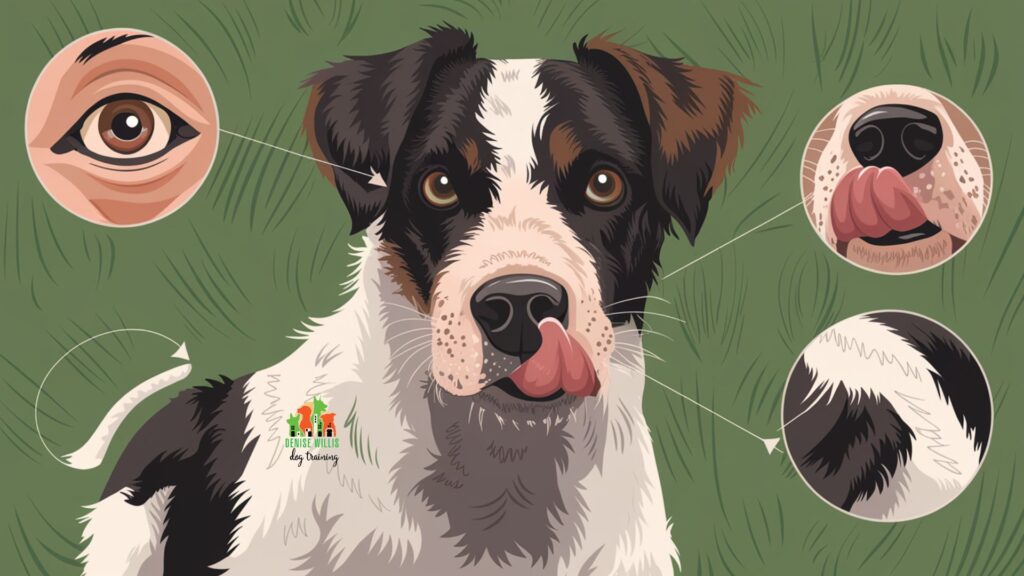
Training Exercises
Training is like giving your dog the tools to be their best self. It’s not about forcing them to behave, but rather teaching them how to make good choices. Here are some key exercises to help prevent redirected aggression:
Impulse Control Exercises
Impulse control is like giving your dog a remote control for their impulses. These exercises teach your dog to think before they act, which is crucial in preventing redirected aggression. Here are some exercises to try:
- “Leave It”: This command teaches your dog to ignore something they want, which is invaluable when faced with potential triggers.
- Start with a low-value treat in one hand and a high-value treat in the other.
- Show your dog the low-value treat and say “Leave it.”
- When they look away or stop trying to get the treat, mark the behavior with a “Yes!” and reward with the high-value treat.
- Gradually increase the difficulty by using more tempting items or leaving the item on the floor.
- “Wait”: This teaches your dog to pause before doing something they want to do.
- Start at doorways or before meals. Ask your dog to “Wait” before allowing them to go through the door or eat their food.
- If they try to move forward, gently block them and repeat the command.
- When they pause, even for a second, mark the behavior with a “Yes!” and allow them to proceed.
- Gradually increase the duration of the wait.
- “Stay”: This command asks your dog to hold a position until released.
- Start with your dog in a sit or down position.
- Say “Stay” and take a small step back.
- If your dog holds the position, mark with a “Yes!” and reward.
- Gradually increase the distance and duration of the stay.
These exercises help your dog learn to control their impulses, which is crucial when faced with potential triggers for redirected aggression.
Focus and Attention Training
Teaching your dog to maintain eye contact is like giving them a default behavior to fall back on in stressful situations. It’s not a staring contest – it’s a connection builder. Here’s how to train it:
- “Watch Me” or “Look at Me”:
- Hold a treat close to your eyes.
- When your dog looks at your eyes, mark with a “Yes!” and reward.
- Gradually increase the duration of eye contact before marking and rewarding.
- Start adding the verbal cue “Watch Me” or “Look at Me” just before your dog makes eye contact.
- Random Rewards for Attention:
- In low-distraction environments, reward your dog whenever they voluntarily look at you.
- Gradually practice in more distracting environments.
- Attention with Distractions:
- Set up mild distractions (like a toy on the floor).
- Ask for your dog’s attention. If they look at you instead of the distraction, mark and reward.
- Gradually increase the level of distraction.
These exercises teach your dog that focusing on you is rewarding, which can help them disengage from potential triggers.
Relaxation Protocols
Teaching your dog to relax on cue is like giving them their own personal chill pill, minus the actual medication. This can be incredibly helpful in managing arousal levels. Here’s a basic protocol:
- “Settle” or “Relax”:
- Start in a quiet environment with your dog on a mat or bed.
- Reward your dog for calm behaviors like lying down, sighing, or resting their head.
- Gradually increase the duration of calm behavior required for a reward.
- Add mild distractions, rewarding your dog for remaining calm.
- Introduce a cue word like “Settle” or “Relax” just before your dog shows calm behavior.
- Dr. Karen Overall’s Relaxation Protocol:
- This is a more structured 15-day program that teaches dogs to relax in increasingly distracting situations.
- It involves asking your dog to stay in a down-stay while you perform various actions, gradually increasing in difficulty.
- Each day has a specific set of exercises to follow.
Remember, consistency is key in all these training exercises. Short, frequent training sessions often yield better results than long, infrequent ones. Always end on a positive note, and don’t hesitate to take a step back in difficulty if your dog is struggling.
By incorporating these exercises into your daily routine, you’re giving your dog the tools they need to better cope with stress and arousal, reducing the likelihood of redirected aggression.
Products and Tools for Management
The joys of shopping for a dog with protective tendencies! It’s like preparing for a four-legged superhero who thinks every delivery person is a supervillain.
We’ve assembled a collection of gadgets that would make even Batman’s utility belt jealous. Let’s help you dive into the world of canine crime-fighting… er, I mean, behavior management tools!
- ThunderShirt Anxiety Jacket: Is your dog auditioning for the role of “Fun Police” at the local park? Wrap them in this snug jacket and watch them transform from Captain America to Bruce Banner. Warning: May cause your dog to believe they’re being hugged by a very persistent octopus.
- PetSafe Gentle Leader Headcollar: Turn your four-legged bodyguard into a perfect gentleman with this headcollar. It’s like a steering wheel for your dog, minus the horn and airbags. Caution: Your dog may temporarily believe they’ve joined a secret dog society where everyone wears fancy face accessories.
- Outward Hound Nina Ottosson Dog Brick Puzzle Toy: Keep your canine Sherlock Holmes busy with this interactive puzzle. It’s like “Escape Room: Doggy Edition,” but with treats instead of clues. Warning: May turn your dog into a treat-finding savant who starts solving your Sudoku puzzles.
- KONG Classic Dog Toy: The Swiss Army knife of dog toys, perfect for redirecting your pup’s protective instincts. It’s like a chew toy, puzzle, and stress ball all rolled into one rubber cone of joy. Caution: Your dog may start expecting you to stuff their entire dinner into this magical red cone.
- Zuke’s Mini Naturals Training Dog Treats: These tiny treats are perfect for rewarding good behavior during training sessions focused on managing redirected aggression. They’re like doggy cryptocurrencies – small, valuable, and your dog will do anything to earn more. Caution: Your dog may start expecting these for every minor achievement, like successfully napping or heroically guarding against the evil mailman.
Remember, while these products won’t turn your protective pooch into a zen master overnight, they’ll certainly make the journey more fun.
And who knows?
With enough puzzle toys and treats, your dog might just decide that being a loving pet is a much better gig than being an overzealous bodyguard.
Professional Intervention
Sometimes, despite our best efforts, we need to call in the big guns. Seeking professional help for your dog’s redirected aggression is not admitting defeat – it’s being a responsible pet owner. Here’s what you need to know:
When to Seek Help
If your dog’s redirected aggression is frequent, intense, or you’re worried about safety, it’s time to call in the pros. It’s like hiring a doggy life coach, but with fewer motivational speeches. Consider professional help if:
- Your dog has bitten or attempted to bite as a result of redirected aggression
- The behavior is getting worse despite your management efforts
- You’re feeling overwhelmed or scared of your dog’s behavior
- The redirected aggression is affecting your daily life or relationship with your dog
Remember, early intervention often leads to better outcomes. Don’t wait until a serious incident occurs to seek help.
What to Expect
A professional can provide:
- Personalized behavior modification plans: A good behaviorist or trainer will assess your specific situation and create a tailored plan to address your dog’s redirected aggression. This might include:
- Specific training exercises
- Management strategies
- Recommendations for environmental changes
- Guidance on safe management techniques: They can teach you how to safely handle your dog during potential trigger situations and how to intervene if necessary.
- Evaluation for potential underlying medical issues: Some behaviorists work closely with veterinarians to rule out any medical causes for the behavior.
- Objective assessment: Sometimes we’re too close to the situation to see it clearly. A professional can provide an unbiased evaluation of your dog’s behavior and progress.
- Support and follow-up: Many professionals offer ongoing support as you implement the behavior modification plan.
It’s like sending your dog to finishing school, but instead of learning which fork to use, they’re learning not to use their teeth as forks.
When choosing a professional, look for someone with experience in aggression cases and who uses positive, science-based training methods. Be wary of anyone promising quick fixes or using punitive methods, as these can often make aggression worse.
Remember, working with a professional doesn’t mean you’re handing over responsibility for your dog’s training. You’ll still need to put in the work at home. Think of the professional as a guide, providing you with the knowledge and tools you need to help your dog.
With the right professional help and your dedication, even severe cases of redirected aggression can often be managed successfully. It’s a journey, but one that can strengthen the bond between you and your furry friend.
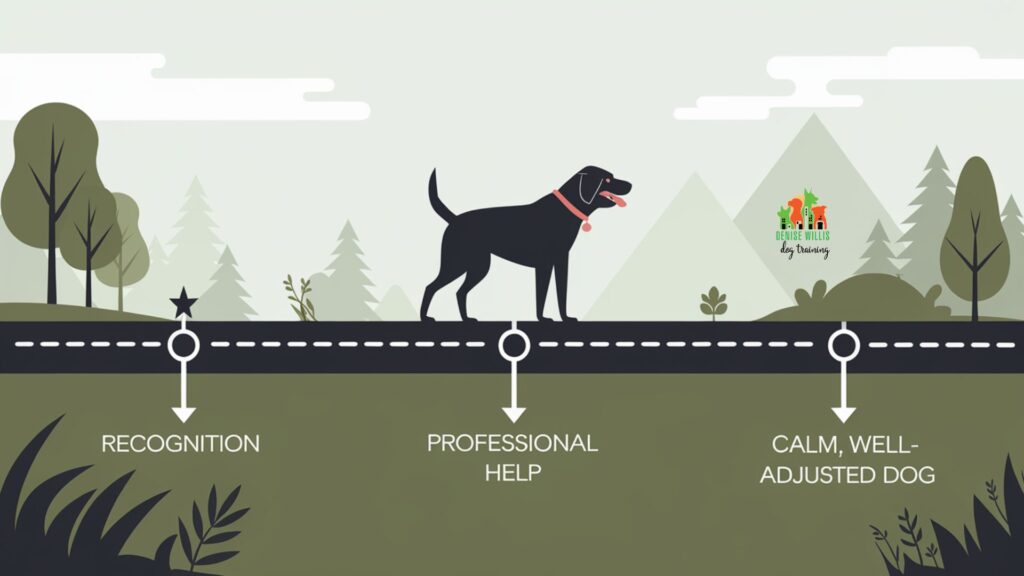
Long-term Management
Managing redirected aggression is not a “one and done” deal. It’s more like a lifelong dance where you and your dog learn to groove together harmoniously. Here’s how to keep the rhythm going:
Consistent Training
Keep up with training exercises. It’s like going to the gym for your dog’s brain – no one said having a six-pack mind would be easy!
- Regular practice: Set aside time each day for training sessions. Even 5-10 minutes can make a difference.
- Reinforce learned behaviors: Don’t assume that because your dog has learned a behavior, they’ll always remember it. Regular reinforcement keeps skills sharp.
- Generalize commands: Practice learned behaviors in different environments and with various distractions.
- Stay positive: Use rewards and praise to keep training fun and engaging for your dog.
Ongoing Socialization
Controlled exposure to various stimuli helps maintain social skills. It’s like doggy cocktail parties, minus the awkward small talk.
- Gradual exposure: Slowly introduce your dog to new people, animals, and environments.
- Positive associations: Always pair new experiences with good things like treats or play.
- Know your dog’s limits: Don’t push too far too fast. Respect your dog’s comfort level.
- Safe spaces: Ensure your dog always has an “out” if they feel overwhelmed.
Regular Health Check-ups
Rule out any developing medical issues. It’s amazing how much nicer dogs are when they’re not in pain – just like humans!
- Annual vet visits: Even if your dog seems fine, yearly check-ups can catch issues early.
- Stay up-to-date on preventative care: Keep vaccinations and parasite prevention current.
- Monitor for changes: Be alert for any shifts in behavior, appetite, or energy levels.
- Consider senior care: As dogs age, they may need more frequent health checks.
Adapting to Life Changes
As your dog ages or circumstances change, be ready to adjust your strategies. It’s like updating your dog’s internal software to run on the latest life operating system.
- Be flexible: What works today might not work tomorrow. Be ready to adapt your approach.
- Watch for new triggers: Life changes can create new stressors for your dog.
- Adjust exercise routines: As your dog ages, they may need different types or amounts of activity.
- Reevaluate management strategies: Periodically assess if your current approaches are still effective.
Remember, long-term management of redirected aggression is about creating a lifestyle that supports your dog’s emotional well-being. It’s not always easy, but the payoff – a happy, well-adjusted canine companion – is worth every ounce of effort.
Impact on Human-Canine Bond
Redirected aggression can put a strain on your relationship with your dog. But with understanding and proper management, many owners report stronger bonds after addressing the issue. It’s like going through couples therapy with your dog – minus the arguing over who left hair in the drain.
Initial Challenges
- Trust issues: After an incident of redirected aggression, you might feel wary around your dog. This is normal, but it’s important to work through these feelings.
- Stress and anxiety: Both you and your dog might experience increased stress in situations that could trigger redirected aggression.
- Lifestyle changes: You may need to alter your routines to accommodate your dog’s needs, which can be frustrating at first.
The Road to Recovery
- Improved communication: As you learn to read your dog’s body language and stress signals, you’ll develop a deeper understanding of their needs.
- Increased empathy: Recognizing that your dog’s aggression comes from a place of stress or fear can help you approach the issue with compassion.
- Shared accomplishments: Working together to overcome redirected aggression can create a sense of teamwork and shared achievement.
Strengthening the Bond
- Quality time: Training sessions and management strategies often involve spending more focused time with your dog, which can enhance your relationship.
- Mutual trust: As your dog learns to look to you for guidance in stressful situations, and as you learn to trust your ability to manage these situations, your bond grows stronger.
- Deeper understanding: The process of addressing redirected aggression often leads to a more nuanced understanding of your dog’s personality and needs.
Remember, addressing redirected aggression is a journey that you and your dog take together. While it may have its challenges, many owners find that it ultimately brings them closer to their canine companions. After all, true friendship isn’t about being perfect – it’s about standing by each other through the ruff times. (Pun absolutely intended!)
Understanding Redirected Aggression in Dogs
What is Redirected Aggression?
Occurs when a dog becomes aroused by a trigger they can’t directly respond to, causing them to redirect their frustration onto an unrelated target nearby.
Common Triggers
Barrier frustration, interrupted conflicts, overstimulation, and inability to reach a desired target can all lead to redirected aggression in dogs.
Warning Signs
Watch for whale eye, lip licking, body tension, and displacement behaviors. These subtle cues can indicate impending redirected aggression.
Prevention Strategies
Implement environmental management, focus on training and exercise, and consider professional help for severe cases of redirected aggression.
Case Studies
Let’s dive into some real-life examples of redirected aggression and how they were addressed. These case studies illustrate the complexity of the issue and the importance of tailored approaches.
Shots, the Reactive Staffie
A case study of a 17-month-old American Staffordshire Bull Terrier named Shots demonstrated how redirected aggression can develop after traumatic experiences. After being attacked by other dogs, Shots became reactive on leash and redirected onto his owner during walks when stressed by the sight of other dogs.
Management strategy:
- Implemented distance-based training to gradually desensitize Shots to other dogs
- Taught alternative behaviors for Shots to perform when he saw other dogs
- Worked on building the owner’s confidence in handling Shots
Outcome: With consistent training and management, Shots’ reactivity decreased, and he stopped redirecting onto his owner.
Rum’s Complex Case
A complex case involving a dog named Rum highlighted how redirected aggression can be part of a broader set of behavioral issues. Rum would redirect aggression onto his owner or housemate dogs when frustrated or aroused by the sight of other dogs. This was linked to impulse control problems and possible sensory integration issues.
Management strategy:
- Implemented a comprehensive behavior modification plan
- Focused on impulse control exercises and relaxation protocols
- Used management techniques to prevent Rum from practicing the unwanted behavior
Outcome: While Rum’s case was complex, consistent application of the behavior plan led to significant improvements in his behavior.
The Unfamiliar Dog Incident
In a study of 65 aggressive dogs following bite incidents, one case specifically involved redirected aggression – a dog bit an unfamiliar dog and then redirected to bite its own owner.
Management strategy:
- Focused on improving the dog’s impulse control
- Implemented careful management to prevent exposure to unfamiliar dogs
- Worked on the owner’s handling skills to safely manage potential trigger situations
Outcome: With proper management and training, the frequency and intensity of aggressive incidents decreased.
Gerhardt’s Journey
A case study of a young male dog named Gerhardt documented multiple bite incidents over several years, some involving redirected aggression. In one incident, Gerhardt air snapped at his owner when she tried to intervene while he was reacting to another dog through a glass door – a classic example of redirected aggression.
Management strategy:
- Addressed underlying anxiety and possible pain issues
- Implemented a structured routine with clear expectations
- Used positive reinforcement to teach alternative behaviors
Outcome: Over time, Gerhardt’s aggressive responses decreased, and he became more relaxed in previously triggering situations.
These case studies illustrate how redirected aggression typically stems from frustration, arousal, or stress, and can manifest even in dogs that are not generally aggressive. They highlight the importance of identifying triggers, managing the environment, and addressing underlying anxiety or impulse control issues in treatment plans.
Myths and Misconceptions About Redirected Dog Aggression
When it comes to redirected aggression in dogs, there’s a lot of misinformation out there. Let’s bust some myths and clear up some common misconceptions:
“My dog is just being dominant.”
Nope, your dog isn’t trying to overthrow you and establish a canine dictatorship. They’re just stressed or frustrated. Redirected aggression is about emotional arousal, not dominance. Your dog isn’t plotting world domination – they’re just having trouble managing their emotions.
“Punishing the dog will stop the behavior.”
This is about as effective as using a water gun to put out a forest fire. It might make things worse! Punishment can increase stress and anxiety, which are often at the root of redirected aggression. Instead, focus on positive reinforcement and addressing the underlying cause of the behavior.
“It’s just a phase; they’ll grow out of it.”
Wishful thinking at its finest. Without intervention, redirected aggression is more likely to become a bad habit than disappear on its own. It’s like hoping your coffee addiction will magically vanish – nice thought, but probably not happening without some effort.
“My dog is doing it out of spite.”
Dogs don’t plot revenge like a furry Machiavelli. They’re reacting to stress, not planning your downfall. Redirected aggression is an in-the-moment response to frustration or arousal, not a calculated act of vengeance. Your dog isn’t staying up late crafting elaborate plans to get back at you for that one time you forgot to buy their favorite treats.
“Once a dog redirects aggression, they can’t be trusted.”
With proper management and training, many dogs can overcome this behavior. Don’t throw in the towel just yet! Redirected aggression is a manageable issue, not a permanent character flaw. It’s like saying someone who stress-eats can never be trusted around a buffet again – with the right strategies, improvement is possible.
“Only ‘bad’ dogs show redirected aggression.”
This couldn’t be further from the truth. Any dog, regardless of breed, age, or typical temperament, can display redirected aggression under the right (or rather, wrong) circumstances. Even the sweetest, most well-behaved dog might redirect if sufficiently stressed or aroused.
“Redirected aggression means my dog doesn’t love me.”
Your dog’s love for you hasn’t vanished just because they redirected aggression onto you. They were simply in a highly aroused state and not thinking clearly – kind of like how you might snap at a loved one when you’re stressed, even though you care about them deeply.
“I just need to show my dog who’s boss to stop redirected aggression.”
Trying to dominate your dog won’t solve the problem and may make it worse. Instead of playing alpha, focus on being a good leader by providing clear guidance, consistent rules, and positive reinforcement.
“Redirected aggression is the same as regular aggression.”
While they may look similar, redirected aggression is distinct from other forms of aggression. It’s a response to a trigger that the dog can’t directly address, rather than aggression aimed at the apparent target. Understanding this difference is crucial for effective management and treatment.
“My dog is too old to change this behavior.”
You can teach an old dog new tricks! While it might take more time and patience, dogs of any age can learn to manage their responses better with the right training and support.
By debunking these myths, we can approach redirected aggression with a clearer understanding, leading to more effective management and happier, healthier relationships with our canine companions.
The Numbers Don’t Lie: Dog Aggression by the Numbers
Ever wondered if your furry friend’s occasional grumpy moment is normal, or if you’re secretly living with Cujo? Well, grab your calculator and put on your statistician hat (yes, that’s a thing), because we’re about to crunch some numbers on canine crankiness!
Before we dive in, remember: these stats are like dog years. They give us a general idea, but every pup is unique. So, don’t panic if your pooch doesn’t fit the mold perfectly. After all, being a bit of an oddball is what makes our furry friends so lovable!
| Statistic | Percentage | Notes | Source |
|---|---|---|---|
| Modified Behavioral Sequence in Aggressive Dogs | 96.1% | Absence of warning signs or multiple bites | [1] |
| Dogs Not Barking/Growling Before Biting | 62% | Highlighting importance of subtle warning signs | [1] |
| Genetic Influence on Aggression Between Breeds | 60-70% | Observed differences in aggression attributable to genetics | [8] |
| Pit Bull Involvement in Reported Bites | 22.5% | Highest percentage among all dog breeds | [4] |
| Small Dogs Exhibiting Aggressive Behavior | 250% | More likely to snap or bite compared to larger dogs | [8] |
Well, there you have it – the 411 on doggy disagreements, served up with a side of percentages.
Surprising, isn’t it?
Who knew our four-legged friends were such complex creatures? (Okay, every dog owner ever, but now we have the numbers to prove it!)
Remember, behind every statistic is a wagging tail and a wet nose. These numbers don’t define our furry friends, but they do help us understand them better. And, understanding is the first step to building a stronger, happier relationship with our canine companions.
So, the next time your pup gives you the side-eye for being late with dinner, just remember – you’re not alone in the doghouse. Millions of other pet parents are right there with you, trying to decode the mysterious language of barks and tail wags.
Further Reading
You’ve made it this far in your quest to understand the mysterious world of canine protective instincts. But why stop now? Dive deeper into the doggy psyche with these paw-some articles. Warning: Side effects may include spontaneous tail-wagging and an irresistible urge to say “Who’s a good boy?”
- 10 Warning Signs Your Dog Might Bite and How to Prevent It: Think your dog’s just smiling with extra teeth? Think again! This article decodes the secret language of canine warnings. Spoiler alert: If your dog starts speaking in Morse code, you’ve probably missed a few earlier signs.
- Decoding Your Dog: 15 Body Language Signals You Need to Know: Ever wish your dog came with subtitles? This guide is the next best thing! Learn to read your dog’s body language like a pro. Caution: May result in you unconsciously tilting your head and wagging your behind when excited.
- How to Manage Your Dog’s Territorial Aggression: Is your dog trying to claim the entire neighborhood as their kingdom? This article helps you negotiate a peace treaty. Bonus: Includes tips on explaining property laws to your furry friend.
- 5 Proven Strategies to Stop Your Dog’s Aggression Towards Other Dogs: Transform your canine confrontationalist into a doggy diplomat with these strategies. Warning: Your dog may start organizing peace summits at the local park.
- Dog Aggression Solutions: A Complete Guide to Stopping Aggressive Behavior in Dogs: The ultimate playbook for tackling canine aggression. It’s like “The Art of War” for dog training, minus the ancient Chinese philosophy (unless your dog is into that).
Dive into these articles and emerge as the Dog Whisperer you were always meant to be.
Frequently Asked Questions About Redirected Aggression in Dogs
Q: How do you treat redirected aggression in dogs?
A: Treatment involves a multi-faceted approach including identifying triggers, managing the environment, behavior modification, and sometimes medication. Having predictable interactions, avoiding aggression-provoking stimuli, and maintaining a good daily routine of exercise, play, and social interaction are key. It’s like being a life coach for your dog, minus the motivational speeches and vision boards.
Q: How do you fix barrier aggression in dogs?
A: Fixing barrier aggression involves desensitization and counterconditioning. Start by choosing a high-value treat and working with your dog in a private fenced area. Reward calm behavior when exposed to triggers at a distance. Gradually decrease the distance as your dog remains calm. It’s like teaching your dog that the grass isn’t always greener (or more threatening) on the other side of the fence.
Q: How do you fix dominance aggression in dogs?
A: First, ditch the notion of “dominance.” Instead, focus on building a positive relationship through consistent leadership, avoiding punishment, and rewarding desired behaviors. Identify triggers, ensure safety, and consider professional help for severe cases. It’s less about being the “alpha” and more about being a good coach for your canine team player.
Q: How do you treat inter-dog aggression?
A: Treatment involves careful management, including separating dogs or intervening before they become too excited. Gradual reintroduction with desensitization and counterconditioning training is often necessary. It’s like being a referee and a therapist for a canine fight club – your goal is to turn it into a peaceful book club instead.
Q: Can redirected aggression in dogs be cured?
A: While “cured” might be a strong word, redirected aggression can often be successfully managed and significantly reduced. With proper training, management, and sometimes professional help, many dogs show great improvement. Think of it less as a cure and more as teaching your dog better coping skills for stressful situations.
Q: Is redirected aggression in dogs dangerous?
A: Redirected aggression can be dangerous if not properly managed, as the dog may bite whoever is nearest, regardless of whether they’re the source of frustration. However, with understanding and proper management techniques, the risks can be significantly reduced. It’s all about being proactive rather than reactive.
Q: How long does it take to see improvement in redirected aggression?
A: The timeline for improvement can vary greatly depending on the individual dog, the severity of the issue, and the consistency of training and management. Some dogs may show improvement in a few weeks, while others may take months. Remember, it’s a marathon, not a sprint – consistency and patience are key.
Test Your Knowledge: Redirected Aggression in Dogs
Final Thoughts
Redirected aggression in dogs is a complex issue, but with patience, understanding, and the right strategies, it's manageable. Remember, your dog isn't trying to be difficult. They're just struggling to handle their emotions, much like a toddler with sharp teeth and a fur coat.
By identifying triggers, managing the environment, and working on training, you can help your furry friend navigate the world with more confidence and less stress.
And who knows?
With enough work, your dog might just redirect their aggression towards more productive pursuits – like finally catching that pesky squirrel (just kidding, please don't let them do that).
If you're struggling with redirected aggression in your dog, don't hesitate to reach out to a professional. At DW Dog Training, we're here to help you and your four-legged friend live your best lives together. Because at the end of the day, a happy dog means a happy human – and fewer apologetic looks at the mailman.
Remember, every dog is unique, and what works for one may not work for another. Be patient with your furry friend, celebrate small victories, and don't forget to take care of yourself in the process.
After all, you're not just training a dog – you're building a stronger, healthier relationship with your canine companion.
So, here's to fewer redirected snaps and more tail wags, to less stress and more joyful walks, to the journey of understanding our dogs better. May your treats be plentiful, your leashes strong, and your bond with your dog unbreakable.

